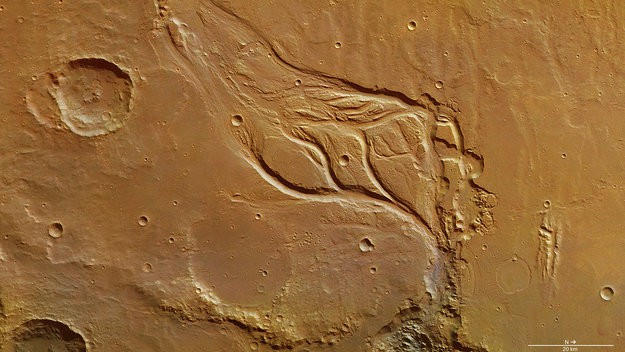
 Beautiful streamlined islands and narrow gorges were carved by fast-flowing water pounding through a small plateau region near the southeastern margin of the vast Vallis Marineris canyon system.
Beautiful streamlined islands and narrow gorges were carved by fast-flowing water pounding through a small plateau region near the southeastern margin of the vast Vallis Marineris canyon system.
Images captured on 7 December 2013 by the European Space Agency’s Mars Express show the central portion of Osuga Valles, which has a total length of 164 km. It is some 170 km south of Eos Chaos, which lies in the far eastern section of Valles Marineris.
Osuga Valles is an outflow channel that emanates from a region of chaotic terrain at the edge of Eos Chaos to the west (top in the main images). Such landscape is dominated by randomly oriented and heavily eroded blocks of terrain. Another example is seen at the bottom of this scene, filling the 2.5 km-deep depression into which Osuga Valles empties.
Catastrophic flooding is thought to have created the heavily eroded Osuga Valles and the features within it. Streamlines around the islands in the valley indicate that the direction of flow was towards the northeast (bottom right in the main color, topographic and 3D images shown here) and sets of parallel, narrow grooves on the floor of the channel suggest that the water was fast-flowing.
Differences in elevation within the feature, along with the presence and cross-cutting relationships of channels carved onto the islands, suggest that Osuga Valles experienced several episodes of flooding. The perspective view, which is oriented with the direction of the water flow towards the top of the image, shows the details of the grooved valley floor and the channels carved into the islands more clearly.
Close to the northern-most (far right) part of the channel in the main images, two large irregular-shaped blocks appear to have broken away from the surrounding terrain, but do not seem to have experienced as much erosion as the rounded islands.
The floodwater eventually emptied into the deep depression of chaotic terrain at the bottom of the main images, but it is not yet known whether the water drained away into the subsurface or formed a temporary lake.
ASTROPOETRY CONTEST EXTENDED UNTIL MAY 31
The deadline for submitting entries to the Astronomers Without Borders (AWB) annual astropoetry contest has been extended to May 31. Poems submitted to the contest can be in any form, but they should relate in some way to stars, planets, sun, moon, space exploration, or the night sky. Poems should be submitted on the special entry form provided. For the 2014 contest details and a link to the submission form, see:
http://astronomerswithoutborders.org/gam2014-programs/astroarts/1467-astropoetry-contest-for-gam2014.html
AWB is an international organization dedicated to increasing awareness of the universe among all peoples. See their website at: www.astronomerswithoutborders.org
Here’s the first-place winning poem from the 2013 contest, Young Adult Division:
I LOOK UP AT THE SKY
BY ZIQI LU, XINXIANG CITY, HENAN PROVINCE, CHINA
I look up at the sky
Starlight, slowly pours like the firefly
Together we feel the night
feel the starlight
The sun shines bright
The moon light, warm and soft
But the many many starlight
They are lovely and I like


Be the first to comment